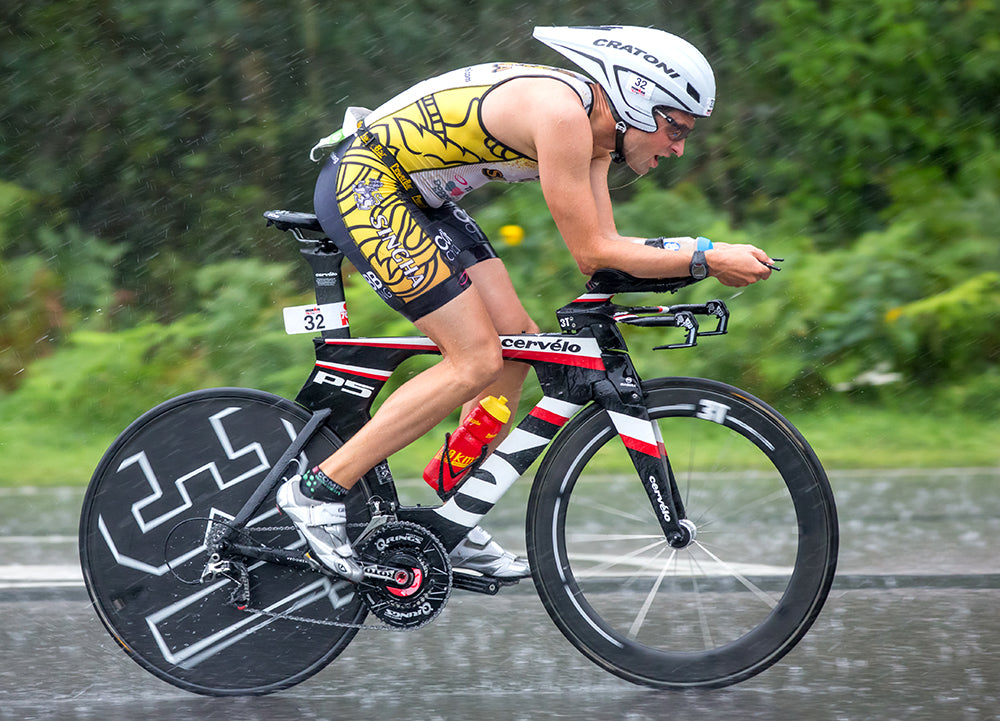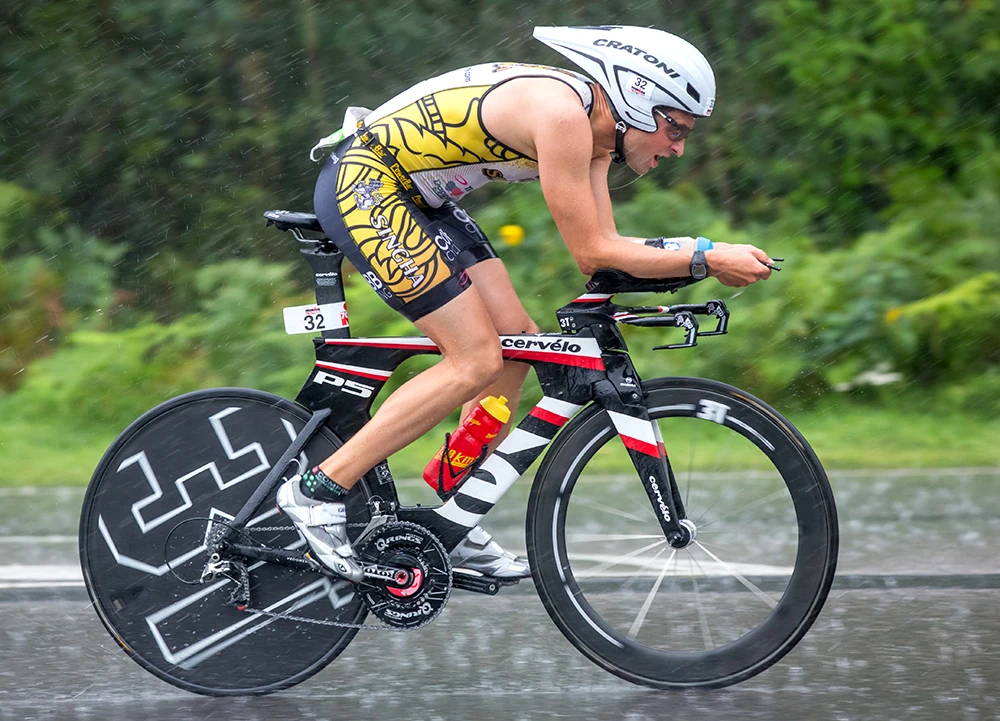Kaum ein Radfahrer dürfte von dieser Situation gänzlich verschont bleiben. Besonders zu Beginn der Radsport-Karriere, oder auch nach Veränderung der Sitzposition, sind sie da: Sitzprobleme. Dann geht sie los, die Suche nach dem richtigen Sattel. Qual und Wahl gehören dann oft zusammen. In der schier unübersichtlichen Vielfalt von Formen, Längen, Breiten und Polster-Varianten den richtigen zu finden ist nämlich gar nicht so einfach. „Es gibt schon einige Anhaltspunkte, anhand derer man die Auswahl einschränken kann,“ verrät uns Christian Nitschke. Der 30-jährige weiß wovon er redet. Als Triathlon-Profi – und das ist er seit sechs Jahren – verbringt man immerhin viele Stunden im Sattel. Noch dazu bringt er mittlerweile auch Sättel an den Mann und die Frau. Wir haben uns mit ihm unterhalten.
Hallo Christian! Als Triathlon-Profi spult man tausende von Kilometern jährlich ab. Wie vermeidet man da Sitzprobleme?

Wie du oben schon erwähnt hast, ist es besonders zu Beginn nicht ganz einfach Sitzprobleme zu vermeiden. Die allermeisten fahren „erstmal“ die vormontierten Sättel und stellen dann, mit wenigen Ausnahmen, schnell fest, dass irgendwas nicht passt. Bei mir war es ähnlich. Besonders der Übergang vom Rennrad zu einem richtigen Zeitfahrrad hat bei mir am Anfang große Probleme verursacht. Zum Glück haben sich in den letzten Jahren einige Hersteller auf genau diese Nische spezialisiert und bieten Sättel für Triathleten und Zeitfahrer an. Sitzprobleme lassen sich eben nur mit einem guten Sattel, der wirklich zu einem passt, beheben. Leider haben die wenigsten Hersteller begriffen das es keine „one fits all“ Lösungen gibt. Jeder ist eben anatomisch etwas unterschiedlich.
Welche Folgen kann ein unpassender Sattel haben und woran erkennt man, dass ein Sattel passt?
Sehr häufig ist unangenehmer Druck an Stellen, die man lieber entlastet hätte… Bei mir persönlich war Scheuern immer ein ganz großes Problem. Wenn man dann gleich am nächsten Tag diese Stellen wieder belastet, kommt es ganz schnell zu Haarwurzelentzündungen, die zu sehr unangenehmen Abszessen heranwachsen können, und dann für längere Zeit das Radtraining unmöglich machen. Damit musste ich leider viele Erfahrungen sammeln. Mittlerweile weiß ich, dass diese Scheuerstellen durch Hin- und Herrutschen auf dem Sattel verursacht werden. Man wechselt, quasi aus der Not heraus, weil sich nichts angenehm anfühlt, ständig die Position.
Rückenschmerzen und Taubheitsgefühle sind auch ganz vorne, bei vom Sattel verursachten Problemen. Da kann die Sitzposition noch so gut eingestellt werden, wenn der Sattel nicht passt, dann kommen die Schmerzen trotzdem. Ganz interessant ist auch, das Krämpfe, die ja viele Ursachen haben können, oft auch mit dem falschen Sattel zusammen hängen. Wenn das Becken in der Zeitfahrposition nicht nach vorne klappen kann, entsteht viel Spannung auf der hinteren Muskelkette und sobald man vom Rad steigt, sind die Krämpfe in den Oberschenkeln da.
Dass ein Sattel passt ist leicht zu erkennen. Man fühlt sich auch nach mehreren Stunden wohl, es wird nichts taub und vor allem sitzt man „wie festgeklebt“. Es kommt gar nicht das Bedürfnis auf, ständig die Position zu wechseln.
In den letzten Jahren drängten vermehrt spezielle Triathlon-Sättel auf den Markt. Worin liegt der Unterschied zu Herkömmlichen?
Der größte Unterschied zwischen Rennrad und Zeitfahrrad ist die unterschiedliche Belastung des Sitzbereichs. Auf dem Triathlonrad rotiert man, um eine bessere Aerodynamik zu erreiche, mit Hilfe des Triathlon Lenkers oder Aufsatzes nach vorne-unten. Im Sitzbereich verlagert sich mit normalen Rennsätteln die Belastung dann genau auf den sehr empfindlichen Damm-Bereich und die Genitalien. Diese Bereiche müssen aber unbedingt entlastet werden, um langfristig ein glücklicher Radfahrer zu bleiben. Sonst fängt man wieder an, von einer Seite auf die andere zu rutschen, um den Druck vom Damm zu bekommen, oder vor und zurück, weil die Genitalien entlastet werden müssen. Da sind wir dann ganz schnell wieder bei den oben beschriebenen Problemen.
Mal ganz zu schweigen davon, dass jedes Hin- und Herrutschen auch effektiv Zeit im Wettkampf kostet. Man verwendet dafür im Wahrsten Sinne des Wortes Kraft, die dann für den Vortrieb fehlt. Die amerikanische Aerodynamik-Koryphäe John Cobb hat den Spruch „comfort equals speed“ geprägt. Da ist auf jeden Fall viel Wahres dran.

Gute Triathlon Sättel ermöglichen auch, durch eine leichte Vertiefung senkrecht zur Aussparung kurz vor Sattelmitte, die Anfangs beschriebene Beckenrotation, um einen Rundrücken, sowie zu viel Spannung auf der hinteren Muskelkette zu vermeiden. Diese kleine Vertiefung ermöglicht auch die Sitzhöhe konstant zu halten, wenn man sich an einem Anstieg aus der Zeitfahrposition aufrichtet und leicht nach hinten rutscht. Der Damm-Bereich wird durch eine mittige Aussparung entlastet und viele Modelle entlasten die Genitalien, indem sich diese noch vor der Sattelnase befinden, und so gar kein Druck entsteht. Die Auflageflächen sind dann beidseitig des empfindlichen Damm-Bereichs und hinter den Genitalen. Dieser Bereich ist in der Regel deutlich unempfindlicher. Eine gute Belüftung des Sitzbereichs ist ebenfalls wichtig, da besonders bei Hitze der Abtransport des Schweißes Scheuern sehr effektiv verhindern kann.
Die Suche nach dem richtigen Sattel gleicht oft der Suche nach einer Nadel im Heuhaufen. Welche Kriterien gibt es, um die Auswahl zumindest schon einmal einzuschränken?
Da spielen einige Faktoren eine Rolle. Die wichtigste Frage, die bei mir in einer Beratung immer am Anfang fällt, ist die Frage nach dem Fahrrad. Haben wir es mit einem Rennrad oder mit einem Zeitfahrrad zu tun? Auch auf dem Rennrad sind viele Athleten unglücklich mit ihrem Sattel, aber hier muss in den allermeisten Fällen „nur“ der Druck vom Damm-Bereich genommen werden, um unangenehme Folgen, wie Schmerzen beim Wasserlassen, zu verhindern. Auch Prostatabeschwerden, ein sehr häufiges Radfahrerproblem, können durch eine sehr große Aussparung vermieden werden. Die Sättel für Rennräder sind in der Regel etwas schmaler, da man in der aufrechten Position eher Probleme mit Scheuern an den Oberschenkelinnenseiten bekommt.
Als nächstes kommt bei mir die Frage nach der Überhöhung zwischen Lenker und Sattel bzw. Auflieger und Sattel. Sie spielt auch eine entscheidende Rolle, mit welchem Sattel man Glücklich wird. Tendenziell kann man sagen, dass eine große Überhöhung in vielen Fällen einen etwas breiteren Sattel fordert. Jetzt kann ich meist schon auf zwei bis drei Modelle einschränken. Wenn ich dann noch ein paar Informationen zur Körpergröße und zum Gewicht bekomme, liege ich mit meinem Tipp in vielen Fällen schon sehr gut.

Bei weiblichen Athleten spielt noch ein anderer wichtiger Punkt eine Rolle. Zu diesem Thema hat John Cobb auch vor einigen Jahren einen sehr interessanten Artikel veröffentlicht. Er unterteilt hier in zwei Gruppen die auch etwa zu 50/50 verteilt sind, die er „innies or outies“ nennt. Ähnlich wie mit dem Bauchnabel, der entweder eher innen oder eher außen liegt verhält es sich mit dem weiblichen Genitalbereich. Dabei ist es so das die „innies“ eher schmale Sättel brauchen, während die „outies“ mit breiteren Modellen glücklich werden. Es ist auf keinen Fall so, wie lange Zeit behauptet wurde, dass Frauen pauschal extrem breite Sättel brauchen! Wer sich damit etwas im Detail auseinander setzen möchte, findet den ganzen Artikel in’s Deutsche übersetzt auch auf meiner Webseite. Auch wenn dieses Thema oft todgeschwiegen wird, lohnt es sich wirklich, sich damit auseinander zu setzen, wenn man als Athletin keine Lust mehr auf einen unbequemen Sattel hat.
Ich habe auf jeden Fall sehr positive Erfahrungen gemacht, wenn man offen mit diesem Thema umgeht.
Probieren geht über studieren – trifft das auch auf Sättel zu? Oder kann man verhindern, am Ende ein dutzend verschiedener Sättel im Keller liegen zu haben, bevor man den richtigen montiert hat?
Ich kann jedem der sich nicht sicher ist nur empfehlen zu testen. Damals als ich meine Probleme hatte gab es leider fast gar keine Möglichkeit dazu und ich bin dann eher zufällig bei den richtigen Sätteln gelandet, da die Firma damals ein Sponsor des TeamTBB war, dem ich vier Jahre angehört habe. Für meine Kunden empfehle ich immer ein Gespräch, in dem ich die oben genannten Punkte abfragen kann. So kann ich auf wenige Modelle einschränken, die dann gegen eine Kaution getestet werden können. So erspart man sich 20 Sättel zu kaufen, bevor man dann endlich den Passenden gefunden hat. Einen Laufschuh kauft schließlich auch kaum noch jemand ohne Probelauf. Meiner Meinung nach ist der Sattel der wichtigste Verbindungspunkt mit dem Fahrrad. Da sollte man dann schon sicher gehen das er zu einem passt.
Profil Christian Nitschke:
Geburtstag: 28.04.1985
Profi seit: 2010
Größte Erfolge: 5 Siege in Folge beim Ostseeman Triathlon in Glücksburg, sowie meine persönliche Bestzeit von 8h17min über die Langdistanz in Köln.
Text: Christine Waitz
Fotos: Christian Nitschke, Ingo Kutsche




















